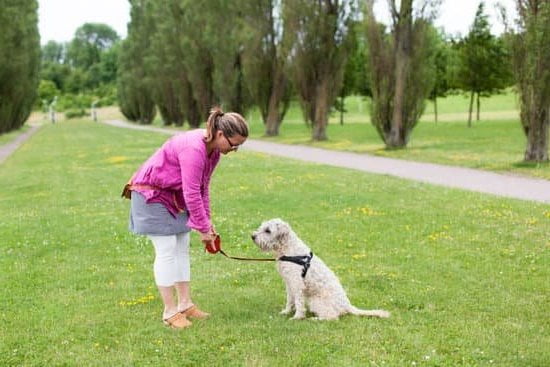Are you tired of coming home to unexpected messes on the floor? Dog training pads may be the solution you’ve been looking for.
These handy tools are designed to make house training your furry friend a breeze, providing a designated spot for them to do their business. In this article, we’ll explore the different types of dog training pads available, how to choose the right one for your pet, training tips for successful use, and the benefits of incorporating them into your routine.
Dog training pads are specially designed absorbent pads that are placed on the floor as a designated potty spot for your four-legged companion. Whether you have a new puppy who is not yet fully house trained or an older dog who needs some extra help, using these pads can make a world of difference in minimizing accidents in the house.
By providing a consistent and easily accessible place for your pet to go, you can effectively teach them where it’s appropriate to do their business.
When it comes to choosing the right dog training pad for your pet, there are several factors to consider. From size and absorbency level to leak-proof barriers and scent options, each pad offers unique features that cater to different needs.
By understanding what sets each type apart, you can ensure that you’re selecting the best option for your beloved pet. In the following sections, we will delve into these considerations and provide guidance on making an informed decision when purchasing dog training pads.
Different Types of Dog Training Pads
When it comes to dog training pads, pet owners have a variety of options to choose from. Understanding the different types of dog training pads available can help you make the best choice for your furry friend. Here are some key considerations when deciding between the various types of dog training pads:
- Disposable vs. washable/reusable: Disposable dog training pads are convenient and easy to dispose of after use, while washable/reusable pads are more eco-friendly and cost-effective in the long run.
- Scented vs. unscented: Scented dog training pads can help attract your pet to use them, while unscented pads may be preferable for pets with sensitive noses or for pet owners who prefer no added fragrance.
- Quilted vs. non-quilted: Quilted dog training pads have a quilt-like texture that helps with quick absorption and moisture lock-in, while non-quilted pads may be a more economical option for pet owners on a budget.
Considering these factors can help you narrow down your choices and select the type of dog training pad that best suits your pet’s needs.
When choosing the right dog training pad, several factors should be taken into account to ensure its effectiveness in house training. It is important to consider:
- Size considerations: The size of the pad should match the size of your pet and fit comfortably within your designated area for potty training.
- Absorbency levels: Different breeds and sizes of dogs have varying urine output, so it’s essential to select a pad with the appropriate absorbency level for your pet.
- Leak-proof barriers: Look for features such as leak-proof backing or sealed edges to prevent any messes from seeping through the pad onto your floors.
By carefully considering these factors, you can ensure that you choose the right dog training pad that will aid in successful house training for your beloved pet.
How to Choose the Right Dog Training Pad
When it comes to house training your furry friend, choosing the right dog training pad is essential for success. With so many options available on the market, it’s important to consider several factors before making a decision. Here are some key points to keep in mind when selecting the right dog training pad for your pet.
Size Considerations
One of the first things to consider when choosing a dog training pad is the size. The pad should be large enough to accommodate your dog’s size and allow for ample space for them to do their business. If you have a larger breed, you may want to opt for a larger pad to ensure maximum coverage.
Absorbency Levels
Another crucial factor to consider is the absorbency level of the dog training pad. This is particularly important if you have a puppy or a senior dog who may have more frequent accidents. Look for pads with high absorbency levels to effectively contain and lock in moisture, preventing leaks and messes on your floors.
Leak-Proof Barriers
Leak-proof barriers are an essential feature of any quality dog training pad. These barriers help prevent liquid from seeping through the pad onto your floors, keeping your home clean and dry. Be sure to choose pads with reinforced edges and leak-proof backing for added protection against accidents.
By considering these factors and carefully evaluating your specific needs, you can choose a dog training pad that best meets the requirements of both you and your canine companion. With the right pad in place, you can streamline the house training process and provide a comfortable and hygienic environment for your pet’s potty needs.
Training Tips for Using Dog Training Pads
When it comes to using dog training pads, there are some essential tips to keep in mind to ensure successful house training for your pet. One important tip is to establish a designated area in your home where you want your dog to use the training pad.
This will help create a consistent routine and make it easier for your pet to understand where they should go when nature calls. By consistently bringing your dog to this designated spot, you can reinforce the behavior you want.
Positive reinforcement techniques are also crucial when using dog training pads. Whenever your dog successfully uses the pad, be sure to praise and reward them. This will help them understand that using the pad is the desired behavior. Punishing or scolding your dog for accidents outside of the designated area can cause confusion and anxiety, making it more difficult for them to learn.
Consistent use and establishing a routine are key factors in successful house training using dog training pads. Make sure to maintain a regular schedule and bring your dog to the designated spot at consistent times throughout the day. This will help reinforce good habits and minimize accidents in other areas of the house.
| Training Tip | Description |
|---|---|
| Establishing a designated area | Create a consistent routine by designating a specific spot for your dog’s training pad. |
| Positive reinforcement techniques | Reward your dog with praise or treats when they successfully use the training pad. |
| Consistent use and routine | Maintain a regular schedule for bringing your dog to the training pad, reinforcing good habits. |
Benefits of Using Dog Training Pads
Using dog training pads can offer numerous benefits for both pet owners and their furry companions. One of the main advantages of using these pads is the convenience they provide. For pet owners who may not have easy access to outdoor areas for frequent potty breaks, dog training pads offer a suitable solution. Additionally, for individuals with busy schedules or limited mobility, these pads can make the house training process more manageable.
Aside from convenience, dog training pads help minimize accidents in the house. Whether it’s due to young puppies who are still learning or older dogs with health issues, accidents can happen. By providing a designated area for dogs to relieve themselves, training pads reduce the likelihood of messes on carpets, floors, and furniture.
Furthermore, using dog training pads can assist with the transition to outdoor potty training. Puppies especially may need time to develop the bladder control and coordination required for regular outdoor bathroom breaks. Training pads serve as a stepping stone in this process by teaching dogs where it’s appropriate to eliminate while they gradually adjust to going outside.
Overall, the benefits of using dog training pads extend beyond just house training-they contribute to a more positive and harmonious environment for both pets and their owners. With proper use and consistent reinforcement techniques, these pads can be an effective tool in promoting good potty habits in dogs of all ages.
Common Mistakes to Avoid When Using Dog Training Pads
Inconsistency in Use
One of the most common mistakes pet owners make when using dog training pads is being inconsistent with their use. It is important to establish a designated area for the training pads and consistently bring your pet to that location when they need to relieve themselves.
Inconsistency can confuse your pet and hinder their house training progress. It’s essential to set a routine and stick to it, ensuring that your pet knows where they should go when they need to potty.
Not Changing Pads Regularly
Another mistake to avoid is not changing the dog training pads regularly. Keeping soiled pads around can be unhygienic for both your pet and your home, as well as discouraging for proper house training. Make sure to change the pad promptly after each use, providing a clean surface for your pet each time they need it. This will also help maintain a fresh environment in your home and prevent unpleasant odors from lingering.
Placing Pads in High-Traffic Areas
Placing dog training pads in high-traffic areas within your home can also impede successful house training. Avoid placing the pads in busy areas where people or other pets frequently walk through, as this can lead to accidents or disturbances for your pet while they are trying to do their business.
Instead, opt for quieter, more secluded areas where your pet can have privacy and feel comfortable using the pads. This will create a positive environment for successful house training with the use of dog training pads.
Review of Top Dog Training Pads on the Market
When it comes to choosing the right dog training pad for your furry friend, there are many options available on the market. Here are some of the top dog training pads that pet owners rave about:
- Brands: Some popular brands known for their quality dog training pads include Petphabet, AmazonBasics, and Four Paws.
- Features: Look for features such as quick-drying materials, odor control, and leak-proof barriers.
- Customer Reviews: Check online reviews and ratings from other pet owners to see which dog training pads are highly recommended.
It’s important to consider your specific needs and requirements when choosing a dog training pad. Whether you prefer disposable or washable/reusable pads, scented or unscented ones, or quilted versus non-quilted pads, there is a product out there that will suit your preferences.
Remember to also take into account the size considerations, absorbency levels, and leak-proof barriers when selecting the right dog training pad for your pet. By doing some research and reading reviews, you can make an informed decision that will help with effective house training for your furry companion.
With the variety of options available in the market today, finding the right dog training pad can be relatively easy with a little bit of guidance and research. Ultimately, using a high-quality dog training pad can greatly assist in successfully house training your pet while providing convenience for both you and your furry friend.
Conclusion
In conclusion, dog training pads are an essential tool for pet owners looking to effectively house train their furry companions. These pads provide a designated area for dogs to relieve themselves, minimizing accidents in the house and assisting with the transition to outdoor potty training. By using dog training pads, pet owners can enjoy the convenience of having a clean and mess-free living space while also providing their pets with a consistent and routine method for bathroom breaks.
When choosing the right dog training pad, it is important to consider factors such as size, absorbency levels, and leak-proof barriers. Whether opting for disposable or washable/reusable pads, scented or unscented, quilted or non-quilted, there are options available to suit every pet owner’s needs and preferences. Additionally, establishing a designated area for the pads and employing positive reinforcement techniques can help in effectively utilizing these training tools.
While using dog training pads, it is crucial to avoid common mistakes such as inconsistency in use, not changing pads regularly, and placing pads in high-traffic areas. By being mindful of these potential pitfalls and following training tips, pet owners can optimize the effectiveness of dog training pads for successful house training.
Overall, dog training pads offer numerous benefits including convenience for pet owners and support in creating a clean and comfortable home environment for both pets and their human companions.
Frequently Asked Questions
Do Dog Training Pads Work?
Dog training pads can be effective in teaching dogs where to relieve themselves, especially for indoor or small dogs. Consistency and positive reinforcement are key to successfully using training pads.
What Is Pad Training for a Dog?
Pad training for a dog involves teaching the dog to use specially designed pee pads for urinating and defecating. The process requires patience, consistency, and positive reinforcement to encourage the desired behavior.
Is It Hard to Train a Dog to Use a Pee Pad?
Training a dog to use a pee pad may not necessarily be hard, but it does require patience and consistency from the owner. Some dogs may pick up on it quickly, while others may take longer to learn and adjust to using the pads regularly.

Welcome to the blog! I am a professional dog trainer and have been working with dogs for many years. In this blog, I will be discussing various topics related to dog training, including tips, tricks, and advice. I hope you find this information helpful and informative. Thanks for reading!





